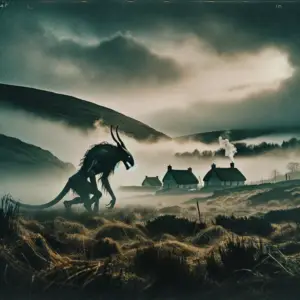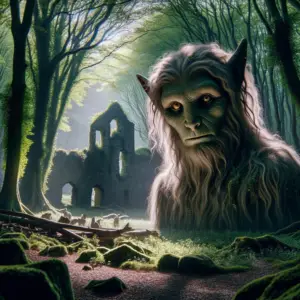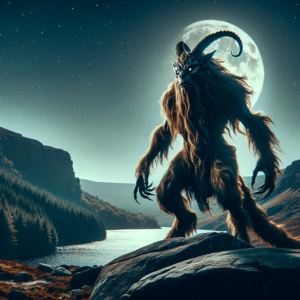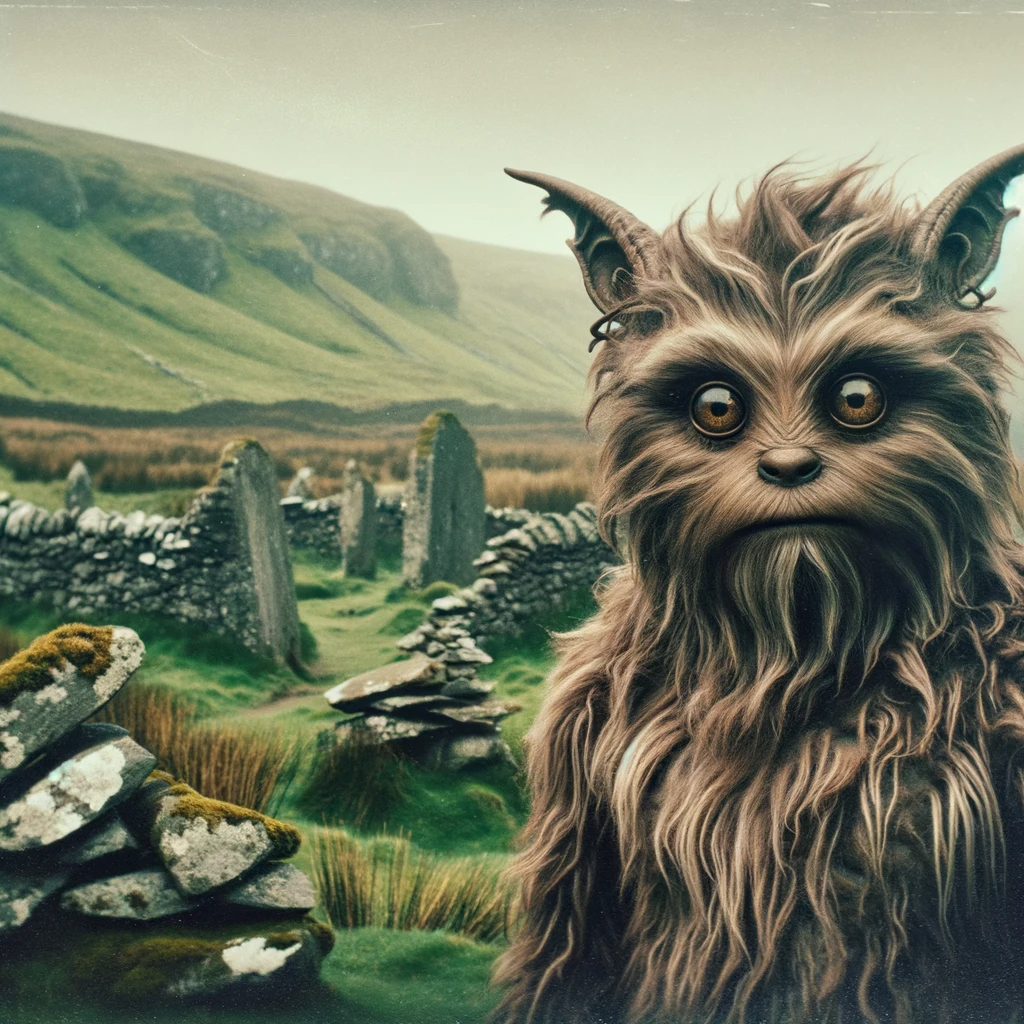The Irish Puca is a fascinating creature of Celtic, English, and Channel Islands folklore.
The Puca creature is a shapeshifting trickster that can take on various forms, including a horse, rabbit, goat, or even a human.
The Puca is known to be a bringer of both good and bad fortune, and its mischievous nature often leads to playing tricks on humans.
In Irish mythology, the Puca is believed to be a supernatural creature that roams the countryside at night.
It is said that if you encounter a Puca, you should be wary of its intentions, as it could either help or hinder you.
The Puca is often associated with the Irish festival of Halloween(Samhain), and it is said that on this night, it becomes more active and mischievous than usual.
Despite its mischievous nature, the Puca creature is a beloved figure in Irish folklore, and its stories have been passed down through generations.
From its shape-shifting abilities to its playful tricks, the Puca is a fascinating creature that continues to captivate the imagination of people all around the world.
The Irish Puca: An Overview
The Irish Puca is a creature of Irish and Celtic folklore that is known for its shapeshifting abilities and its association with good and bad fortune.
In the Irish language, the creature is known as Púca, Puca, or Pooka, which means “spirit” or “ghost.”
The creature is also referred to as “the bringer of good and bad” in Irish folklore.
The Puca is a trickster spirit that can take on many forms, including a domestic animal or a human with animal features.
It is primarily associated with rural and marine communities and is said to bring both good and bad luck to those it encounters.
The creature is often depicted as a goblin or a mischievous spirit that likes to play pranks on humans.
In Irish folklore, the Puca is known for its unpredictable nature and its ability to change its appearance at will.
It is said to be both helpful and harmful to humans, depending on its mood and the situation. The creature is often associated with the harvest season and is said to be responsible for the success or failure of crops.
Despite its reputation as a mischievous spirit, the Puca is also revered in Irish folklore as a powerful and mystical being.
It is said to possess magical powers and is often sought out by those who are in need of help or guidance. In some stories, the creature is even depicted as a protector of the land and its inhabitants.

Physical Description and Forms
The Puca is a shapeshifting creature of Irish folklore that is known for its ability to assume a variety of forms. It is often described as a mischievous trickster that can take on both terrifying and pleasing forms. The following sub-sections describe some of the most common forms that the Puca is said to take:
The Puca as a Black Horse
The Puca is perhaps most commonly known for appearing as a black horse. In this form, it is said to be able to gallop at incredible speeds, often carrying unsuspecting riders on wild and dangerous rides. The black horse form is also associated with the Puca’s darker and more malevolent aspects.
The Puca as a Rabbit
The Puca is also known to take the form of a rabbit. In this form, it is said to be small and cute, but also mischievous and tricky. The rabbit form is often associated with the Puca’s playful and harmless aspects.
The Puca as a Cat
The Puca is sometimes said to take the form of a cat. In this form, it is said to be sly and cunning, often playing tricks on unsuspecting humans. The cat form is also associated with the Puca’s ability to see in the dark and its magical powers.
The Puca as a Dog
The Puca is also known to take the form of a dog. In this form, it is said to be loyal and protective, often serving as a companion and guide to humans. The dog form is also associated with the Puca’s ability to sense danger and its connection to the natural world.
The Puca as a Bull
The Puca is sometimes said to take the form of a bull. In this form, it is said to be strong and powerful, often symbolizing fertility and abundance. The bull form is also associated with the Puca’s connection to the land and its role as a protector of nature.
The Puca as an Eagle
The Puca is also known to take the form of an eagle. In this form, it is said to be majestic and powerful, often soaring high above the earth. The eagle form is also associated with the Puca’s ability to see far and wide and its connection to the sky and heavens.
The Puca as a Woman
The Puca is sometimes said to take the form of a woman. In this form, it is said to be beautiful and alluring, often luring unsuspecting humans into dangerous situations. The woman form is also associated with the Puca’s ability to manipulate and control others.
The Puca as a Black Goat
The Puca is also known to take the form of a black goat. In this form, it is said to be mysterious and otherworldly, often symbolizing the darker aspects of nature. The black goat form is also associated with the Puca’s connection to death and the underworld.
The Puca as a Fox
The Puca is sometimes said to take the form of a fox. In this form, it is said to be sly and cunning, often playing tricks on humans. The fox form is also associated with the Puca’s ability to navigate through the world and its connection to the natural world.
The Puca as a Fire
The Puca is also known to take the form of fire. In this form, it is said to be powerful and destructive, often symbolizing transformation and change. The fire form is also associated with the Puca’s ability to purify and cleanse.
Behavior and Nature of the Puca
The Puca as a Trickster
The Puca is a shapeshifting creature of Celtic folklore known for its mischievous nature. It is often portrayed as a trickster, playing pranks on humans and animals alike. The Puca is said to have the ability to transform into various forms, including a horse, goat, or even a human with animal features. This shape-shifting ability makes it difficult to identify and predict the Puca’s behavior.
The Puca and Mischief
The Puca is known for its love of mischief. It is said to enjoy playing tricks on humans, such as leading them astray or stealing their belongings. However, the Puca is not inherently evil and can also bring good fortune to those it favors. It is important to treat the Puca with respect and caution, as it can quickly turn from a helpful ally to a mischievous adversary.
The Puca and Conversation
The Puca is said to be a creature of conversation, enjoying discussions with humans and animals alike. It is known to be intelligent and witty, often engaging in philosophical debates with those it encounters. However, it is important to be cautious when conversing with the Puca, as it may use its wit and charm to trick or deceive.
The Puca in Irish Folklore and Stories
The Puca and Samhain
One of the most well-known stories involving the Puca is its association with Samhain, the ancient Celtic festival that marks the end of the harvest season and the beginning of winter.
According to legend, the Puca would roam the countryside on Samhain night, playing tricks on unsuspecting villagers and causing mischief wherever it went.
The Puca and Brian Boru
Another famous story involving the Puca is its connection to Brian Boru, the High King of Ireland who lived in the 11th century.
According to legend, the Puca appeared to Brian Boru in the form of a horse and helped him win a crucial battle against his enemies. In return, Brian Boru promised to honor the Puca and its kind.
The Puca in At Swim-Two-Birds
The Puca also appears in the novel At Swim-Two-Birds by Irish author Flann O’Brien. In the novel, the Puca is portrayed as a mischievous and unpredictable character that is both feared and respected by the other characters.
The Puca’s antics play a key role in the plot of the novel and help to create a sense of mystery and intrigue.

The Puca in Rural Life and Agricultural Traditions
The Puca and Crops
In Irish folklore, the Puca is a creature that can bring both good and bad fortune to rural and marine communities. When it comes to crops, the Puca is known to play tricks on farmers, such as stealing their produce or leading them astray. However, the Puca can also be helpful, as it is said to have the power to ensure a bountiful harvest.
The Puca and Farmers
Farmers in rural Ireland have long been aware of the Puca and its potential influence on their livelihoods. Some believe that leaving offerings of food or drink for the Puca can help ensure a successful harvest, while others take precautions to ward off the creature’s mischievous behavior.
The Puca and Harvest
Harvest time is a particularly important time for farmers, as it marks the culmination of their hard work throughout the year. However, it is also a time when the Puca is said to be most active. Farmers must be careful not to offend the Puca, as it can bring bad luck to their crops and livelihoods.
Despite its reputation for trickery, the Puca is an important part of Irish agricultural traditions. Its presence serves as a reminder of the importance of respecting the natural world and the creatures that inhabit it.
The Puca in Popular Culture
The Puca, a shapeshifting creature from Irish folklore, has made its way into popular culture through various mediums. This section will explore two examples of the Puca’s appearances in popular culture: the film Harvey and the legend of the Kildare Hunt.
The Puca in Harvey
The 1950 film Harvey features a character named Elwood P. Dowd, who has an imaginary friend named Harvey. While Elwood describes Harvey as a six-foot-tall rabbit, it is suggested throughout the film that Harvey may actually be a Puca. The Puca is known for its shapeshifting abilities, and it is possible that Harvey appears to Elwood as a rabbit due to his own perception of the creature.
The Puca and the Kildare Hunt
The legend of the Kildare Hunt involves a group of hunters who attempt to capture a Puca in order to prove their bravery. However, the Puca outwits the hunters and leads them on a wild chase, eventually causing them to fall into a bog and drown. This legend has been retold in various forms throughout Irish folklore and has made its way into popular culture as well.
In the television series Killing Eve, the character Villanelle tells a story about the Kildare Hunt to a young girl, using it as a metaphor for the dangers of underestimating one’s opponent. This example showcases how the legend of the Puca and the Kildare Hunt has continued to resonate with audiences and inspire new interpretations.
Puca Mythology In Different Regions
The Puca in County Down
County Down, located in Northern Ireland, has its own version of the Puca. The creature is known as the Pooka and is said to be a shape-shifter that often takes on the form of a horse. In County Down, the Pooka is known for being mischievous and playing pranks on people. It is said that if you hear the sound of a horse’s hooves at night, it could be the Pooka causing trouble.
The Puca in Roscommon
In Roscommon, the Puca is known for being a helpful creature that aids farmers in their work. It is said that the Puca will come to a farm at night and complete all of the work that needs to be done. However, if the farmer is ungrateful or disrespectful to the Puca, it will cause trouble instead.
The Puca in Laois
The Puca in Laois is known for being a creature of the night. It is said that the Puca will often take on the form of a black goat and roam the countryside. The Puca is known for being a trickster and will often lead travelers astray or cause mischief.
The Puca in the Channel Islands
In the Channel Islands, the Puca is known as the Puck. The Puck is said to be a shape-shifter that often takes on the form of a black goat or a black dog. The Puck is known for being mischievous and causing trouble for sailors and fishermen.
The Puca in Brittany
In Brittany, the Puca is known as the Pouk. The Pouk is said to be a shape-shifter that often takes on the form of a horse or a donkey. The Pouk is known for being a helpful creature that aids farmers in their work. It is said that if a farmer is respectful to the Pouk, it will help with the harvest and protect the crops. However, if the farmer is disrespectful, the Pouk will cause trouble instead.
Beliefs and Superstitions around the Puca
The Puca and Bad Fortune
The Puca is a creature of Celtic folklore that is believed to bring both good and bad fortune. It is said that if one encounters a Puca, it is best to treat it with respect and caution, as it can be mischievous and unpredictable. In some stories, the Puca is known to lead people astray and cause them harm, while in others, it brings good luck and blessings.
The Puca and Cold Iron
One of the most well-known beliefs surrounding the Puca is its aversion to cold iron. It is said that if one carries a piece of cold iron, such as a horseshoe, it can protect them from the Puca’s mischief. Some even believe that the mere sight of cold iron is enough to ward off the creature.
The Puca and the Stirrup Cup
Another superstition related to the Puca is the tradition of the Stirrup Cup. This is a drink that is offered to a traveler as they mount their horse, and it is believed to protect them on their journey. It is said that if one forgets to offer the Puca a Stirrup Cup, they may face misfortune on their travels.
Comparisons and Connections to Other Entities
The Puca and the Pooka
The Puca and the Pooka are often considered to be the same entity. The word “pooka” is derived from the Irish word “phouka,” which is another name for the Puca. Both creatures are known for their mischievous nature and their ability to shape-shift into various forms.
The Puca and the Phooka
As mentioned earlier, the Puca and the Phooka are essentially the same entity. The term “phooka” is simply another name for the Puca.
The Puca and the Bucca
The Bucca is a creature from Cornish folklore that is similar to the Puca. Like the Puca, the Bucca is known for its mischievous nature and its ability to shape-shift. However, the Bucca is often depicted as a malevolent creature that can cause harm to humans.
The Puca and the Pwca
The Pwca is a Welsh creature that is similar to the Puca. Like the Puca, the Pwca is known for its mischievous nature and its ability to shape-shift. However, the Pwca is often depicted as a helpful creature that can bring good luck to humans.
The Puca and the Phouka
As mentioned earlier, the Phouka is simply another name for the Puca.
The Puca and the Changeling
The Changeling is a creature from Irish folklore that is often associated with the Puca. According to legend, the Puca would sometimes steal human children and replace them with Changelings, which were often sickly and mischievous. As an Irish kid, the story of the Changeling is something that terrified me.
The Puca and the Devil
The Puca is sometimes associated with the Devil, due to its mischievous nature and its ability to shape-shift. However, it is important to note that the Puca is not considered to be an evil creature in Irish folklore.
The Puca and the Bogeyman
The Bogeyman is a creature from English folklore that is often associated with the Puca. Like the Puca, the Bogeyman is known for its mischievous nature and its ability to scare people.
The Puca and the Sprite
The Sprite is a creature from various mythologies that is often associated with the Puca. Like the Puca, the Sprite is known for its mischievous nature and its ability to shape-shift.

Frequently Asked Questions
What is Puca Mythology?
The púca, also known as the pooka, is a creature of Irish folklore that has been around for centuries. The story goes that the púca is a shape-shifter, often taking the form of a horse, goat, or other animal. It is said that it can be helpful or mischievous, depending on its mood.
What are pookas known for?
Pookas are known for their shape-shifting abilities and their mischievous nature. They are often associated with Halloween and the harvest season, and it is said that they can bring good or bad luck.
Where does the púca live?
The púca is said to live in the Irish countryside, particularly in areas where there are hills or mountains. It is often associated with the harvest season and can be seen in fields at night.
Is a Pooka a fairy?
While the púca is often referred to as a fairy, it is not the same as the small, delicate fairies that are often depicted in popular culture. The púca is a much more mischievous and unpredictable creature.
What is a puka in Irish?
In Irish, puka (or púca) means “ghost” or “spirit”. It is a word that is deeply rooted in Irish folklore and culture.
What is the pronunciation of púca?
The word púca is pronounced “poo-ka” with the emphasis on the first syllable.
To learn more about the Irish Puca, check out this video below:


